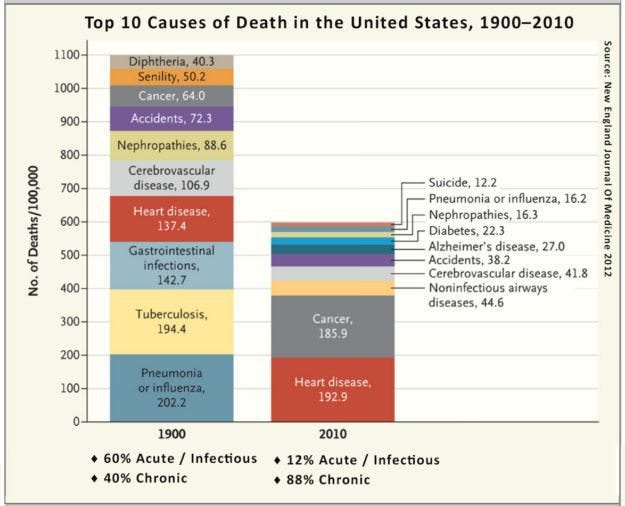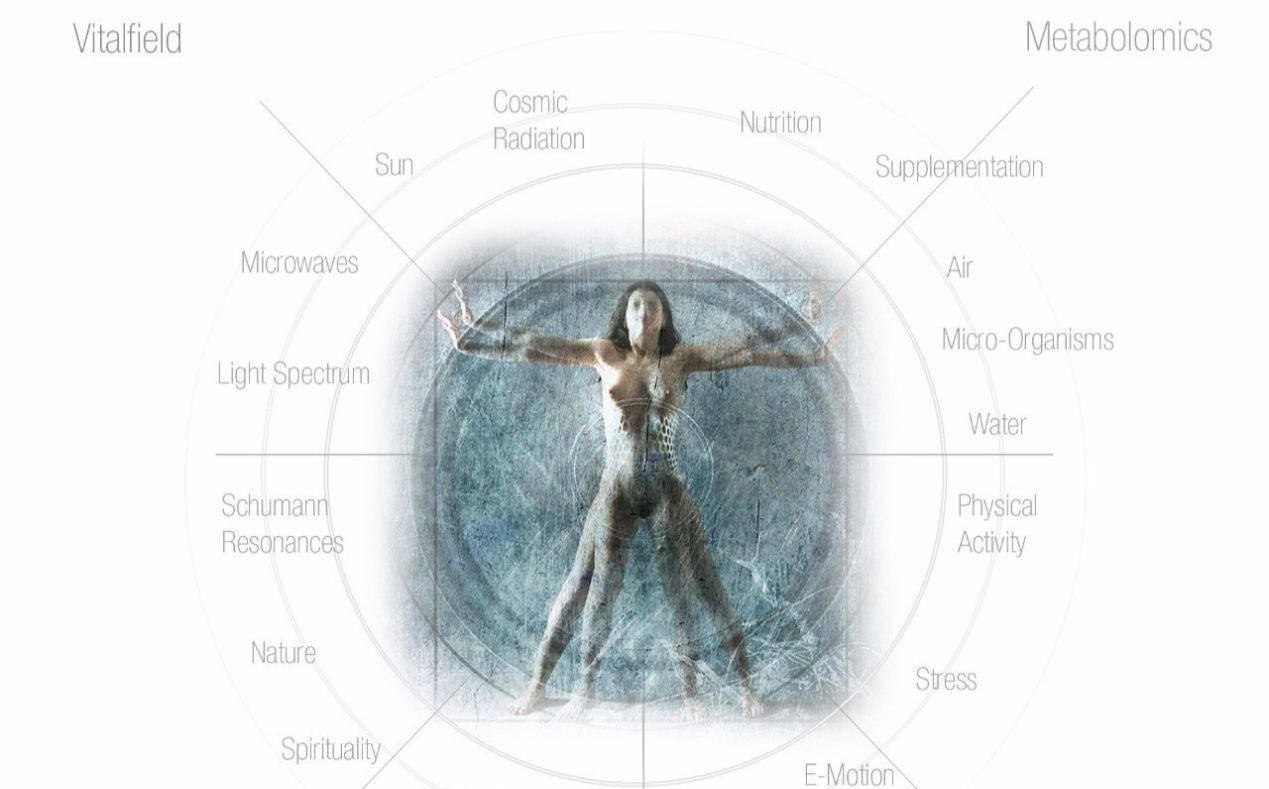Written by Jan Wellmann https://energyforliving.com
Part 1
“Vis medicatrix natural,” a.k.a. “the body heals itself naturally,” wrote Hippocrates, the father of Western medicine, two and a half millennia ago. Meaning, given proper nutrition and a safe environment (short on poisons, killer microbes, or flying bullets) the human body self-regulates a biochemical balance that represents an optimal physiological and mental state, otherwise known as “health.”
Health should be our biological norm. Yet, in the last century, it’s become an anomaly.
According to a 2012 study by the England Journal Of Medicine, 60 percent of deaths in 1900 were attributable to acute causes (infections, tuberculosis, influenza, etc.), whereas in 2010, the overwhelming majority of deaths (88 percent) were due to chronic illnesses (cancer, heart disease, degenerative conditions).
Cause of Death 1900 vs. 2010 in U.S.

The Global Burden of Disease Study (GBD) points to a grimmer picture. Just one in 20 people worldwide were healthy, while one in three experienced more than five ailments in 2013.
The surge in chronic illnesses over the last century reflects a historic paradigm shift. We live longer than ever, yet we’ve never been a sicker species.
The Riddle Of Chronic Illness
The rapidly escalating variety and number of chronic illnesses is a modern scourge. There are now over 150 autoimmune conditions (58 million cases in America alone) — counting just the ones that have been identified by modern medicine. Half the women and two-thirds of men will get cancer in their lifetime, with over 100 forms of cancer to pick and choose from. Then there is diabetes. Asthma. Arthritis. Cardiovascular diseases. Degenerative brain diseases like Alzheimer’s. And a wide spectrum of debilitating mental health conditions like depression.
Our collective health is in a statistical freefall — with petite public awareness of the fact. Like Wile E. Coyote, we’re chasing a Roadrunner (life’s daily grind) over a precipice, then happily skedaddling above the abyss, until we notice someone waving a red-neon warning sign.
In my case, the warning sign was a near-death experience with an antibiotic-boosted superbug. Doctors who kept prescribing more antibiotics nudged me to research natural alternatives. After I healed myself with colloidal silver — a millennia old natural antimicrobial that is deemed quackery by modern medicine — I began to question what else was out there that deserved more attention. I began to pick up new clues about the precipice.
A puzzling number of friends, family, and colleagues were getting sick, becoming sicker, or dying from diseases labeled with incomprehensible modern acronyms. My father shriveled away in front of me from a chronic illness. But I didn’t know at the time. I was simply told by the experts that there was “no need” to continue life support.
Chronic illness takes a long time to develop, which makes it more dangerous than most acute conditions. The body may perform significantly below its energetic potential, degrading faster than it should, before the disease becomes apparent. Living below our natural energy potential is how we jive today — we just don’t know any better.
Even in the later stages of chronic disease, the majority of the people who live with debilitating symptoms, live in chronic denial about it. Their life quality devolves slowly enough to create the “boiling frog” syndrome. The water gets warmer in sufficiently small increments for them to ignore it — until it’s their cells that are boiling.
The ones who decide to get help, face a plastic smile from their doctors. The diagnosis is overwhelmingly “incurable.” Modern medicine has barely caught up with the classification of new chronic diseases. Ergo, patients are treated for symptoms, with immune suppressants, antibiotics, and other pharmaceuticals that may provide temporary relief, but don’t stop the progress of the disease itself.
If you try to gain objective data about your particular chronic condition, you’re faced with a deluge of material, most of which is slanted towards selling you a symptomatic relief. Practitioners of both modern and alternative medicine attempt to cash in on the demand with equal fervor.
You’ll likely confront an informational Goliath, years of trial and error, experimentation and failures, with little odds of real healing — unless you’re lucky enough to discover the proverbial David with a slingshot.
I came across one by sheer accident.
How Do You Spell “Metabolomic”?
You don’t come across the term “metabolomic” too easily unless you spell it into your search bar. You might guess it has something to do with metabolism. Very few doctors are even aware of the term. And like anything new, metabolomics is often met with skepticism, even by those in the know. But make no mistake. According to MIT Technology Review, metabolomics is one of the fastest growing breakthrough technologies. In 2000 there were zero studies published on metabolomics — by 2012 there were over 2,000. Today a vast amount of metabolomic data is being used to redefine nutritional science. But actual metabolomics practitioners are, well, hard to find.
The center of the metabolomics revolution today is in Athens, the hometown of Hippocrates. It is spreading through Italy, Switzerland, Netherlands, Turkey, and the rest of Europe like a word-of-mouth forest fire, about to hit North America. The patients who experience the effects of metabolomics have become its emissaries. Reason being: metabolomics works.
Metabolomics is the first truly Hippocratic branch of medicine that empowers the body to heal itself by identifying and balancing the precise biochemical roots of chronic disease in the human body.
The key to metabolomics is that every individual’s metabolism is as unique as a fingerprint. That’s why the concept of a universal cure for any chronic condition is faulty, whether it comes from alternative herbs or modern drugs. There is no “fix-all” solution, method or approach, unless we first understand what exactly is the cause of the individual biochemical imbalance.
In metabolomics, the novel factor is the precise measurement of how the human combustion engine converts and uses energy. A customized blood and urine test records over 5,000 “metabolites” — the molecular byproducts that represent the biochemical traces of the human furnace. Any blockades, toxin accumulation, mitochondrial wear and tear, or nutritional deficiency shows up as a marker in the scan results, after which it can be addressed with laser-targeted nutrition, supplements, and lifestyle change.
The key to success is individualization of analysis and treatment.
Linus Pauling, a quantum chemist, biochemist and one of the founders of molecular biology, could be considered the father of metabolomics. He predicted a new branch of medicine already in his 1954 Nobel lecture. “We may, I believe, anticipate that the chemist of the future who is interested in the structure of proteins, nucleic acids, polysaccharides, and other complex substances with high molecular weight will come to rely upon a new structural chemistry … and that great progress will be made, through this technique, in the attack, by chemical methods, on the problems of biology and medicine.”
Linus Pauling was also the founder of “orthomolecular medicine,” a branch that attributed disease to a biochemical misbalance and its treatment to proper nutrition.
“The nutritional microenvironment of our body cells is crucially important to health, and deficiencies in this environment constitute a major cause of disease,” Pauling said.
By combining the “chemist of the future” with the principle of orthomolecular medicine, you wind up with metabolomics.
I heard the term for the first time in 2015 while visiting a friend in Athens.
George, 49, was convalescing from his own spectrum of ailments. He couldn’t stop raving, with Greek-accented English, about how “metabolix” had changed his life (the pronunciation made me think of Hergé’s Asterix and Obelix, the comic book characters who drank a miracle potion made by the village druid, Getafix, and then proceeded to beat up Roman armies with new vigor). I nodded a placatory “uh-oh” to a range of “miracle” supplements George lined up in front of me. My experience with Getafix type solutions had been disappointing in the past. George could sense my hesitation. The next day he dragged me to meet the leading metabolomic expert in the world, who happened to be his friend. The meeting changed my life.
Learning Through Transforming
Dr. Dimitris Tsoukalas, 51, doesn’t look like a village druid. He has jet black hair and the presence of a healthy, keen, bright-eyed man in his mid-30s (his biological age was recently measured at 32). He explained the basics of metabolomics to me in the time it takes to clear your throat.
“There are only two reasons for chronic disease,” says Dimitris. “One is lack of proper nutrients, the other is an accumulation of damage faster than the body’s ability to repair. We identify and address both by tracking your metabolites.”
It sounded too simple for me, but I had resolved to suspend my disbelief until further notice. I thought about questions and wiped the sweat off my forehead. I was secretly nervous. I hadn’t done proper medical checks in years. I felt fit, ate consciously, and exercised 3–4 times a week, but I was also 50 years old, way overdue statistically for Judgement Day.
“So, shall we get you fixed up?” he said with a grin, reading my thoughts.
After doing a blood and urine test, I had a follow-up meeting two weeks later. I was still sweating. If any of what I had read or heard was true, I was about to get a deep insight into both my present and future health. Metabolomic tests utilize a probability curve (based on over 15,000 case studies) to predict your health progression, should you continue your present lifestyle and diet.
The data slapped me in the face.
I wasn’t dying imminently, but I also wasn’t living optimally. Some of my neurotransmitter levels were off, in the region of 8000%. My Krebs cycle, the process in which mitochondria (the cell’s batteries) turn nutrients into cellular energy (ATP) was operating at about 60 percent efficiency levels. Several other markers were either slightly off, or about to go off.

What struck me most was that I was living 40 percent below my energy capacity. If someone had given the same evaluation of my car’s engine, I would have sued the manufacturer. In California jargon, I was experiencing a bummer. But then another thought occurred to me. Now that I knew the truth about my biochemical misbalance, maybe this metabolomic wizardry also had the tools to fix it.
Dr. Tsoukalas’ nutritionist customized my dietary and supplementation regimen for the next three months. It was the beginning of my most profound physiological shift in life.
The most important realization for me was that we’re all unique in terms of our dietary requirements. There is no single “health diet.” My personal profile was that of a carnivore, a caveman to be more accurate. My body needed pure, organic meat for protein. I had gone way overboard with veggies. I was also consuming too much sugar. Although I thought I had quit sugar a decade ago, the tests pointed to excessive intake of red wine, orange juice and fruit, along with other simple and complex carbs.
My individual plan boiled down to a ketogenic diet, high in fats (up to 65 percent), medium in proteins (25 percent) and marginal in carbs (10 percent). Bread, flour, pasta, rice (which I used to love), even quinoa, flew out the door. I learned to treat fruit as “nature’s candy,” something a Paleolithic man would come across maybe once a week. Sugar, henceforth, was damnation in powdered form. The same went for all processed food. Not only are they void of any nutritional value, they’re also packed with industrial chemicals and preservatives, i.e. toxins.
A note on junk food: the staple American “Cafeteria Diet” contains on average about 12 percent fat, 23 percent protein and 65 percent carbs. This type of diet is associated with mitochondrial dysfunction, weight gain, and tissue inflammation, and also an increase of activity in the areas of the brain that process motivational control and reward behavior. It works like crack cocaine. You have to have more junk, to reward yourself, while you journey down the path of obesity and chronic illness.
Learning about a truly functional diet involves breaking numerous Western dietary myths, of which the most destructive is the low-fat myth. The fact is that the more (good) fats you digest, the more fat you burn. The accumulation of fat in the body, which today has reached epidemic proportions (70 percent of Americans are obese, i.e. have more than 25 percent body fat), is mostly due to high carb intake. Excessive carbs convert into glucose and raise insulin levels, which signal the body to store the carbs as fat. The higher your Body Mass Index, the higher the likelihood of fat induced disease, especially coronary and diabetes.
Another myth we’ve been taught for 50 years by medical authorities is that cholesterol is caused by fat, which in turns causes coronary disease. Yet the opposite is true. Cholesterol is vital to our existence, essential as a building block of the cellular membrane, to our nervous system, and hormone production. High cholesterol levels actually indicate that the body is inflamed and attempting to heal. Therefore, lowering your cholesterol levels artificially may be dangerous. Yet we’re constantly being sold foods and pills that “lower cholesterol.”
The list of incongruities between Western diet and what your body actually needs deserves a magnum opus. But it’s good to start from the basics, like the fact that high-quality saturated fats provide a steady supply of energy, reduces inflammation, and helps lose weight, thereby reducing the probability of chronic illness.
As a result, my diet shifted towards virgin coconut oil, high-grade olive oils, saturated fats in meats, eggs, and organic butter and dairy, with special emphasis on monounsaturated fatty acids found in avocado, olives, beef and nuts, along with omega-3 fatty acids in fish.
Ketogenic diet may not be for everyone (depending on the individual profile) but the principle of avoiding carbs is relevant for the majority of our species. Strict vegetarianism is another extremist fad to be avoided, which may be disappointing for a massive health food community, but is also apparent in the number of complications in strict vegetarians. The deeper you dig, the more you discover a golden middle road between plant and meat diet that is both ethical and wholesome.
Aside from the dietary plan, I went heavy on supplementation with metabolically formulated vitamins, probiotics, amino acids, trace minerals, and enzymes. The number of supplements you need to end up taking may cause some head-shaking at first, until you realize that even organic foods have 10–20 times less nutrients than they had only 50 years ago (due to industrial farming, soil erosion, use of pesticides, etc.)
We live in a new, nutrition-scarce reality which requires new methods of survival. Heavy supplementation is one of them. An individualized, nutrition-rich diet is another.













